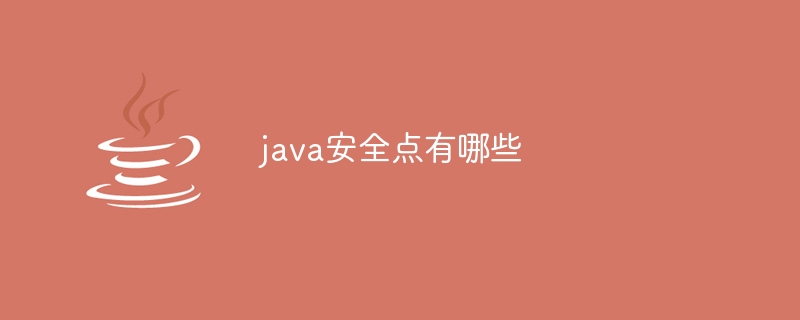What are the security points in java?
Java safe points are specific moments when the JVM pauses threads to perform garbage collection to ensure that the application state is stable and reduce pause time. Safe points are typically located at method calls, loops, and synchronized block boundaries. After the JVM sends the request, the thread will be paused at the nearest safe point, then the JVM will perform garbage collection, and the thread will continue executing after the collection is completed. Optimizations include incremental garbage collection, concurrent mark scans, and biased locking to reduce pause times and avoid impacting application execution.

Java Safe Point
Java Safe Point means that the Java Virtual Machine (JVM) suspends all application threads to The specific moment at which garbage collection is performed.
The role of safe points
- Allow the JVM to perform garbage collection while the application is running
- Ensure the execution status of the application during garbage collection Does not change
- Reduce application pause time
The location of safe points
Safe points are usually located in the following scenarios:
- Method call boundaries: When a thread calls another method, safe points are inserted before and after the method call.
- Loop boundaries: Safe points are inserted when a thread enters or exits a loop.
- Synchronized block boundaries: Safe points are inserted when a thread enters or exits a synchronized block.
Safe point mechanism
When the JVM is ready for garbage collection:
- It will send a safe point request to all Application thread.
- All threads will stop execution after reaching the nearest safe point.
- JVM performs garbage collection.
- Application threads continue execution after garbage collection is completed.
Optimizing safe points
To reduce application pause time, the JVM can optimize safe points in the following ways:
- Incremental garbage collection: Break the garbage collection process into smaller increments, thereby reducing the pause time of a single safe point.
- Concurrent mark scan: Perform the garbage collection marking phase while the application is executing, thereby reducing application pause time.
- Biased lock: Avoid competing for lower lock synchronization, thereby reducing safe point waiting time.
The above is the detailed content of What are the security points in java?. For more information, please follow other related articles on the PHP Chinese website!

Hot AI Tools

Undresser.AI Undress
AI-powered app for creating realistic nude photos

AI Clothes Remover
Online AI tool for removing clothes from photos.

Undress AI Tool
Undress images for free

Clothoff.io
AI clothes remover

AI Hentai Generator
Generate AI Hentai for free.

Hot Article

Hot Tools

Notepad++7.3.1
Easy-to-use and free code editor

SublimeText3 Chinese version
Chinese version, very easy to use

Zend Studio 13.0.1
Powerful PHP integrated development environment

Dreamweaver CS6
Visual web development tools

SublimeText3 Mac version
God-level code editing software (SublimeText3)

Hot Topics
 Top 4 JavaScript Frameworks in 2025: React, Angular, Vue, Svelte
Mar 07, 2025 pm 06:09 PM
Top 4 JavaScript Frameworks in 2025: React, Angular, Vue, Svelte
Mar 07, 2025 pm 06:09 PM
This article analyzes the top four JavaScript frameworks (React, Angular, Vue, Svelte) in 2025, comparing their performance, scalability, and future prospects. While all remain dominant due to strong communities and ecosystems, their relative popul
 Spring Boot SnakeYAML 2.0 CVE-2022-1471 Issue Fixed
Mar 07, 2025 pm 05:52 PM
Spring Boot SnakeYAML 2.0 CVE-2022-1471 Issue Fixed
Mar 07, 2025 pm 05:52 PM
This article addresses the CVE-2022-1471 vulnerability in SnakeYAML, a critical flaw allowing remote code execution. It details how upgrading Spring Boot applications to SnakeYAML 1.33 or later mitigates this risk, emphasizing that dependency updat
 How does Java's classloading mechanism work, including different classloaders and their delegation models?
Mar 17, 2025 pm 05:35 PM
How does Java's classloading mechanism work, including different classloaders and their delegation models?
Mar 17, 2025 pm 05:35 PM
Java's classloading involves loading, linking, and initializing classes using a hierarchical system with Bootstrap, Extension, and Application classloaders. The parent delegation model ensures core classes are loaded first, affecting custom class loa
 How do I implement multi-level caching in Java applications using libraries like Caffeine or Guava Cache?
Mar 17, 2025 pm 05:44 PM
How do I implement multi-level caching in Java applications using libraries like Caffeine or Guava Cache?
Mar 17, 2025 pm 05:44 PM
The article discusses implementing multi-level caching in Java using Caffeine and Guava Cache to enhance application performance. It covers setup, integration, and performance benefits, along with configuration and eviction policy management best pra
 Node.js 20: Key Performance Boosts and New Features
Mar 07, 2025 pm 06:12 PM
Node.js 20: Key Performance Boosts and New Features
Mar 07, 2025 pm 06:12 PM
Node.js 20 significantly enhances performance via V8 engine improvements, notably faster garbage collection and I/O. New features include better WebAssembly support and refined debugging tools, boosting developer productivity and application speed.
 Iceberg: The Future of Data Lake Tables
Mar 07, 2025 pm 06:31 PM
Iceberg: The Future of Data Lake Tables
Mar 07, 2025 pm 06:31 PM
Iceberg, an open table format for large analytical datasets, improves data lake performance and scalability. It addresses limitations of Parquet/ORC through internal metadata management, enabling efficient schema evolution, time travel, concurrent w
 How to Share Data Between Steps in Cucumber
Mar 07, 2025 pm 05:55 PM
How to Share Data Between Steps in Cucumber
Mar 07, 2025 pm 05:55 PM
This article explores methods for sharing data between Cucumber steps, comparing scenario context, global variables, argument passing, and data structures. It emphasizes best practices for maintainability, including concise context use, descriptive
 How can I implement functional programming techniques in Java?
Mar 11, 2025 pm 05:51 PM
How can I implement functional programming techniques in Java?
Mar 11, 2025 pm 05:51 PM
This article explores integrating functional programming into Java using lambda expressions, Streams API, method references, and Optional. It highlights benefits like improved code readability and maintainability through conciseness and immutability






